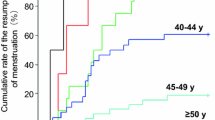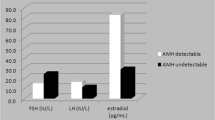Abstract
It has been suggested that the timing of surgery during periods of unopposed estrogen circulation, when high blood levels of estrogen and low blood levels of progesterone exist, has a deleterious effect on the survival of premenopausal patients with breast cancer. We studied this controversial issue by examining the serum estradiol and progesterone levels of 38 premenopausal patients with primary breast cancer, and by analyzing data on 100 premenopausal patients treated for primary breast cancer. The survival of 31 patients who had undergone initial surgery between days 3 and 12 after their last menstrual period (group E) was compared with that of 69 patients who had undergone surgery between days 0 and 2 or from 13 days after their last menstrual period (group P). The overall survival of group E was significantly worse than that of group P (P=0.049). This difference was especially notable in patients with node-positive tumors or tumors larger than 2 cm in size; however there was no significant difference in disease-free survival between the two groups. On a multivariate analysis, nodal status was the only significant prognostic factor for both overall and disease-free survival. Thus, these findings suggest that unopposed estrogen circulation may be detrimental to the overall survival of premenopausal women with breast cancer.
Similar content being viewed by others
References
Hrushesky WJM, Bluming AZ, Gruber SA, Sothern RB (1989) Menstrual influence on surgical cure of breast cancer. Lancet ii:949–952
Badwe RA, Gregory WM, Chaudary MA, Richards MA, Bentley AE, Rubens RD, Fentiman IS (1991) Timing of surgery during menstrual cycle and survival of premenopausal women with operable breast cancer. Lancet 337:1261–1264
Senie RT, Rosen PP, Rhodes P, Lesser ML (1991) Timing of breast cancer excision during the menstrual cycle influences duration of disease-free survival. Ann Int Med 115:337–342
Saad Z, Bramwell V, Duff J, Girotti M, Jory T, Heathcote G, Turnbull I, Garcia B, Stitt L (1994) Timing of surgery in relation to the menstrual cycle in premenopausal women with operable breast cancer. Br J Surg 81:217–220
Larsen NS (1993) Optimal timing of breast cancer surgery: findings revive debate (News). J Natl Cancer Inst 85:605–607
Powles TJ, Ashley SE, Nash AG, Tidy A, Gazet JC, Ford HT (1991) Timing of surgery in breast cancer (Letter). Lancet 337:1604
Ville Y, Briere M, Lasry S, Spyratos F, Oglobine J, Brunet M (1991) Timing of surgery in breast cancer (Letter). Lancet 337:1604–1605
Sainsbury R, Jones M, Parker D, Hall R, Close H (1991) Timing of surgery for breast cancer and menstrual cycle (Letter). Lancet 338:392
Low SC, Galea MH, Blamey RW (1991) Timing breast cancer surgery (Letter). Lancet 338:691
Goldhirsch A, Gelber RD, Forbes J, Price K, Castiglione M, Rudenstam CM, Lindtner J, Hacking A, Senn H (1991) Timing breast cancer surgery (Letter). Lancet 338:691–692
Marques LA, Franco EL (1993) Association between timing of surgery during menstrual cycle and prognosis in pre-menopausal breast cancer (Letter). Int J Cancer 53:707–708
McGuire WL, Hilsenbeck S, Clark GM (1992) Optimal mastectomy timing. J Natl Cancer Inst 84:346–348
Kaplan EL, Meier P (1958) Nonparametric estimation from incomplete observation. J Am Stat Assoc 53:457–481
Japanese Breast Cancer Society (1992) Histological classification of breast tumors. In: General rules for clinical and pathological recording of breast cancer (in Japanese). Kanehara, Tokyo, pp 15–51
Cox DR (1972) Regression models and life tables. J R Stat Soc 34B:187–220
Yen S (1986) The human menstrual cycle in reproductive endocrinology. In: Yen Samuel SC, Jaffe RB (eds) Reproductive endocrinology, physiology, pathophysiology, and clinical management. Saunders, Philadelphia, pp 126–151
Japanese Breast Cancer Society (1992) Classification of nodal status. In: General rules for clinical and pathological recording of breast cancer (in Japanese). Kanehara, Tokyo, p 7
Dickson RB, Bano M, Johnson MD, Shi TE, Martinez-Lacaci I, Amundadottir LT, Ziff B, Kurebayashi J (1994) Steroid regulation of growth factors and protooncogenes in the normal and malignant mammary gland. In: Khan SA, Stancel GM (eds) Protooncogens and growth factors in steroid hormone induced growth and differentiation. CRC Press, London, pp 143–174
Horwitz KB, Freidenberg GR (1985) Growth inhibition and increase in insulin receptors in anti-estrogen resistant T47-Dco human breast cancer cells by progestins: implication for endocrine therapy. Cancer Res 45:167–173
Pollak MN (1991) Timing of surgery in breast cancer (Letter). Lancet 337:1604
Kirkham N, Jones DB (1991) Timing of surgery in breast cancer (Letter). Lancet 337:1605
Pollak MN, Huynh HT, Lefebvre SP (1992) Tamoxifen reduces insulin-like growth factor I. Breast Cancer Res Treat 22:91–100
Author information
Authors and Affiliations
Rights and permissions
About this article
Cite this article
Kurebayashi, J., Sonoo, H. & Shimozuma, K. Timing of surgery in relation to the menstrual cycle and its influence on the survival of Japanese women with operable breast cancer. Surg Today 25, 519–524 (1995). https://doi.org/10.1007/BF00311308
Received:
Accepted:
Issue Date:
DOI: https://doi.org/10.1007/BF00311308




